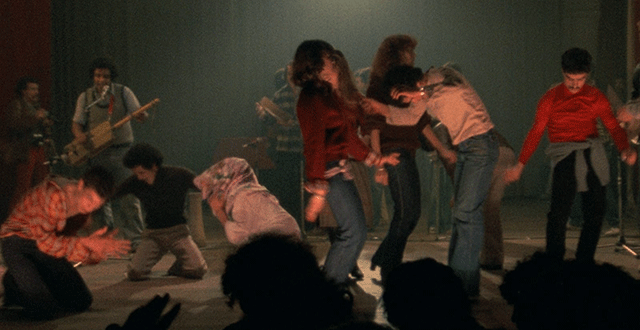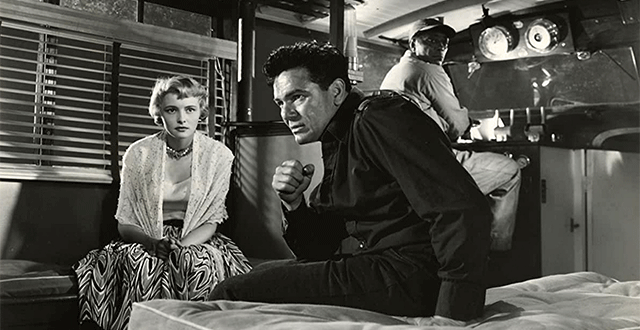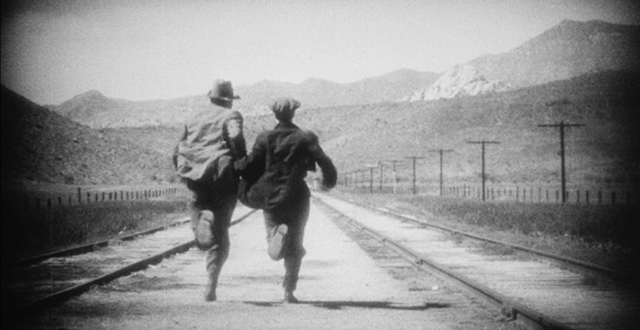News
COMMEMORATING 30 YEARS OF TFF
The first title that was restored under the banner of The World Cinema Project in 2007 was Ahmed El-Maânouni’s Trances, or El Hal, from Morocco. The film had a very particular meaning for Martin Scorsese, who caught it for the first time in 1981 on the USA Network. It was part of a then brand new show called “Night Flight,” which ran through the late night hours and mixed music documentaries, regular segments like “New Wave Theater,” early rock videos and episodes of old Monogram movies with Bela Lugosi and cartoons from Fleischer Studios and Ub Iwerks—in the old rock clubs, the DJs used to put segments together between bands that were often comprised of films of that vintage together with music by, say, The Residents or Pere Ubu. Marty was cutting The King of Comedy by night with Thelma Schoonmaker when he saw Trances that first time, and it really obsessed him—the sound and the image.
The classification of Trances as a documentary doesn’t quite do it justice. Because the film doesn’t just document the music of the legendary band Nass El-Ghiwane, but actually responds to it: one artistic form generates another. This is broadly true of any good music documentary, but the hallucinatory flow of El-Maânouni’s images is an intimate response to the flow of the music, itself a response to the collective spirit of the nation during the first years of independence. The band, which became known as “The Rolling Stones of Morocco,” began in theatre: the band members were part of the Municipal Theatre of Casablanca in the early 70s, and their first songs were created for the company’s stage productions. Laarbi Batma, Boujemaa Hagour, Omar Essayed and Allal Yaala (Moulay Abdelaziz Tahiri joined later and Maalem Abderrahmane Baca joined in 1974 following Boujemaa’s death from lung cancer) came from all over Morocco, and they sang of everyday life, the hardships of men and woman trying to make a living—no small thing in a de-colonized monarchy. The name they gave themselves roughly translates as “disciples of the Ghiwanes,” a brotherhood of Sufi storytellers, and they drew from Berber rhythms, Melhoun sung poetry and Gnawa dances. They played only traditional acoustic instruments: bendir, sentir, frame drums, ghimbri, tambourines, derbouka, and, from the west, a fretless banjo. But as Scorsese says, the sound of their trance music is so big and powerful that you’d swear you’re hearing electric guitars. As you can see in the film, the connection between Nass El-Ghiwane and their audience ran so deep that the authorities stepped in to contain and often shut down the concerts—they’d never seen anything remotely comparable.
If you don’t know this film and the music that inspired it into being, you should sit down and watch and listen: it sings the spirit of common life at an exalted level.
- Kent Jones
Follow us on Instagram, and Twitter!
TRANCES (1981, d. Ahmed El-Maanouni)
Restored in 2007 by Cineteca di Bologna/L’Immagine Ritrovata laboratory, in association with The Film Foundation’s World Cinema Project, Ahmed El-Maanouni, and Izza Genini. Restoration funded by Armani, Cartier, Qatar Airways and Qatar Museum Authority.
Out of the Vaults: The Breaking Point (1950)
Meher Tatna
When Eddie Muller, president of the Film Noir Foundation, introduced a screening of The Breaking Point on TCM, he told the story of Ernest Hemingway and director Howard Hawks on a fishing trip in 1939 when Hawks told Hemingway he could make a decent movie from his worst book. When Hemingway asked him which book that would be, Hawks answered, “That piece of junk, To Have and Have Not.” Hawks did make the movie in 1944 with Humphrey Bogart and Lauren Bacall in her debut performance, but Hemingway would be forgiven if he didn’t recognize his story onscreen – aside from the title and the protagonist’s name, the film had nothing to do with the book.
1950’s The Breaking Point, however, is faithful to Hemingway’s book, using a different title as Hawks had already used To Have and Have Not. This version was directed by Michael Curtiz, specifically requested by star John Garfield who got the lead role of Harry Morgan, a WWII veteran scratching out a living in Balboa Island (the location was moved from Key West) as the owner of a boat he charters out to fishermen and tourists. Curtiz had been responsible for Garfield’s debut in Four Daughters in 1938 and had gone on to great success with Casablanca in 1942 and White Christmas in 1954, among many others. Garfield, who had left Warner Bros. to form an independent production company, had found his career on the downswing. This was his return to WB and an attempt to regain his former popularity.
In the story, Harry needs money desperately to support his wife (played by Phyllis Thaxter) and two little girls. He agrees to take a client and his mistress Leona (Patricia Neal) to Mexico where the man skips out on him without paying, leaving Harry to fend off Leona’s advances and figure out how to get home. An encounter with a shady lawyer called F.R. Duncan (Wallace Ford) who offers him a deal to smuggle some Chinese immigrants into the US ends badly. Then the Coast Guard impounds his boat. Increasingly frantic because of the huge debt he still carries on the boat, Harry takes up Duncan’s offer of another dubious deal when Duncan gets him his boat back. This time he is the getaway driver for a gang of thieves. Once again, things go sideways ending in a spectacular gunfight on the boat.
The Breaking Point is film noir at its best, with outstanding performances by the cast, especially Thaxter’s in the less glamorous role as Harry’s wife. Despite having to keep the family together on a shoestring and the stubbornness of her husband who refuses to find other work, their domestic scenes together show a chemistry and even a sensuality that is unusual for the era. “I can think about you any time and get excited,” she tells him. There is one heartrending scene in which she dyes her hair blond just like Leona’s to appeal to Harry. He is stunned and stammering; her humiliation is complete.
Garfield always maintained that this was his favorite performance, and indeed he makes the most of the charismatic but broken captain who makes terrible choices for the right reasons, struggling to adjust to a post-war world. Neal is the quintessential femme fatale, probably the most beautiful one in all of film noir, a character not in the novel. But the heart of the film is Juano Fernandez’s character Wesley Park, a Black man, and Harry’s first mate and friend. A composite character from Hemingway’s novel, the film eschews the novel’s casual racism and turns Wesley into a dignified and faithful friend at a time when the South was still segregated. The Breaking Point has one of the best last shots of any film – a visual of one person whose life has shattered through no fault of his own alone and bewildered – it lacerates your heart and makes you forget to breathe. There is no question the movie is better than the book. Hemingway himself said it was the best adaptation of any of his books. The film’s poster is headlined by “Screaming off the pages of the Hemingway story!!”
The Breaking Point never got the credit it deserved when it was released. Garfield’s name had appeared on a list of communist sympathizers because his wife Roberta Seidman had been a member of the Communist party. Garfield was summoned to testify before the U.S. Congressional House Committee on Un-American Activities (HUAC) and refused to name names. His career effectively ended. Jack L. Warner would not publicize the movie and there would be no more movie offers for Garfield. Despite excellent reviews, The Breaking Point faded. Garfield would make one more movie after this which he produced himself; he died of a heart attack in 1952 at age 39.
Warner Bros. worked with YCM Laboratories to restore The Breaking Point, and Martin Scorsese’s The Film Foundation provided an additional set of preservation elements for deposit at the UCLA Film & Television Archive. The new elements consist of a duplicate picture negative made from Warner’s fine-grain master positive, a duplicate track negative made from Warner’s track positive, a composite print made from the new duplicate picture and track negatives, and an answer print from the original nitrate picture and track negatives.
Preservation funding was provided by Warner Bros., the Hollywood Foreign Press Association, and The Film Foundation.
COMMEMORATING 30 YEARS OF TFF
William Wellman directed just short of 80 movies between 1923 and 1958, of all kinds. Some are renowned classics. Some are genuinely terrible. Some are ambitious and some are lightweight entertainments. And many of his films—like most of his astonishing pre-code output at Warner Brothers (17 movies in three years)—are bursts of pure cinematic energy. The Film Foundation has helped to restore three of Wellman’s films, with the Academy, the AFI, UCLA and the George Eastman Museum. Beggars of Life, a late silent and partial talkie (the sound sequences are lost) made at Paramount in 1928, throbs with the energy between Richard Arlen and Louise Brooks. The scene where they meet for the first time is a wonder. Brooks is a farm girl who has just murdered her abusive stepfather in self-defense. Arlen, a hobo, wanders into the house in search of food, sizes up the situation and immediately understands that she needs a protector, and they take to the road together. The freshness and pure beauty of their presences, the wordless exchange of emotions, the sudden shift into action and flight, make for one of the most beautiful entries into a movie that I know, and their physical and emotional journey—they meet up with a pack of potentially dangerous hobos led by Wallace Beery—is rough and vivid and lyrical. There is a real kinship with certain Jean Renoir films from the 30s, Toni and The Lower Depths in particular, albeit in a bright, brash American key. It’s interesting to note that both Wellman and Renoir were flyers in the First World War.
In the 40s, Wellman made one of the very few films about war that really feels like it was made by someone who went to war. The Story of G.I. Joe, based on the frontline dispatches of war correspondent Ernie Pyle, portrays the camaraderie and above all the fatigue of war so beautifully and eloquently. Like Beggars of Life, but in a far more sombre key, it pulses with life. And it brings to mind a point that many people have made over the years about the directors who began in the silent era, and that I think bears repeating. In 1978, Scott Eyman interviewed Wellman, and he asked him about how one learns to become a movie director. Wellman gives him an answer that’s as true in its aim as one of his best movies: “You have to learn how to live before you learn how to direct.”
- Kent Jones
Follow us on Instagram, and Twitter!
BEGGARS OF LIFE (1928, d. William Wellman)
Restored by the George Eastman Museum with funding provided by The Film Foundation.
THE STORY OF G.I. JOE (1945, d. William Wellman)
Restored by the Academy Film Archive with funding provided by the Hollywood Foreign Press Association and The Film Foundation.
Out of the Vaults: The Man with the Golden Arm (1955)
Meher Tatna
When director Otto Preminger bought the rights to make The Man with the Golden Arm, he knew he would have problems with the Production Code Administration: he knew they would refuse to grant him a Code seal to release the movie. The film dealt with drug abuse, a subject that was censored, along with miscegenation, prostitution, abortion, and words like “virgin” and “pregnant.” Undeterred, Preminger started production on the picture, vowing to release it without the seal if he had to. United Artists, the studio backing the film with a million-dollar investment, was behind him, despite the certainty of a $25,000 fine from the MPAA, and despite the fact that Preminger had given it an out if the seal was denied. UA resigned from the MPAA (it rejoined later) and released the film through the many cinemas that were willing to book it. Following the controversy that ensued, there was an investigation of the PCA’s Code approval process, and the 25-year-old Code was overhauled for the first time since its adoption in 1930.
The Man with the Golden Arm finally received a seal in 1961 and Preminger, to whom the rights had reverted, sold the television rights to ABC, who were contractually bound not to cut the film. Preminger even got to decide where the commercial breaks would be inserted.
The film was based on Nelson Algren’s 1949 bestselling book of the same name, the first to win a National Book Award. Algren sold the film rights to UA, was hired and then fired as the film’s screenwriter, and later disavowed the film, saying that it bore little resemblance to the story he wrote.
In the film, Frank Sinatra plays Frankie Machine, a poker dealer (the man with the golden arm), who has just been released from prison. He has kicked his drug habit thanks to the prison doctors and now wants to give up gambling and become a musician. He returns to his life in Chicago and to his wife Zosh (Eleanor Parker, borrowed from MGM), a malingering invalid in a wheelchair who wants things to go back the way they were, and repeatedly thwarts his dream of playing in a band. Slowly, Frankie finds himself sucked into his old bad habits, despite the best efforts of his girlfriend, played by Kim Novak, borrowed from Columbia. (Columbia was paid $100,000 for her; she made $1,000 a week.) Robert Strauss plays Schweifka, the poker boss who lures Frankie back with the promise of money for his sick wife; Darren McGavin plays his ruthless pusher Louie.
Sinatra turns in a fine performance as the addicted Frankie; his natural charm makes a weak character seem sympathetic as he struggles through his recidivism and his eventual attempt to “kick the monkey.” The star spent time at drug rehabilitation facilities studying inmates in order to inform his performance. Most of the cast is equally strong, particularly McGavin as Louie – he’s seen it all in his jaded life, and he knows before Frankie does, that all it will take is the offer of a free fix for Frankie to fall. Equally good is Arnold Stang as the dimwitted sneak thief Sparrow, faithful to his friend Frankie until Frankie has no time for him anymore. The one performance that is below par is that of Parker, playing Zosh in a hyper, borderline hysterical way, indicating her character rather than performing in a truthful way.
Preminger was widely known as a bullying director, hectoring his actors and routinely humiliating them, famous for quotes like “I do not welcome advice from actors, they are here to act,” and “Marilyn Monroe? A vacuum with nipples.” However, he did guide nine actors (including Sinatra) to Oscar-nominated performances and had a successful career in Hollywood despite his difficult reputation.
When both Sinatra and Brando were offered the role of Frankie, Sinatra swooped in and commandeered it, smarting from the fact that he had lost On the Waterfront to his rival. His instincts were right, and he was nominated for an Oscar for Best Actor. The film also got nominations for art direction for Joseph C. Wright and Darrell Silvera, and for the score for Elmer Bernstein.
The distinctive crooked arm on the poster and publicity materials for the movie, designed by Saul Bass, is considered a tour de force of movie marketing and was listed by Premiere magazine as one of ‘The 25 Best Movie Posters Ever. In the paper-cut animation on the title credits, white bars appear and disappear against a black background accompanied by Bernstein’s score, ending with the same disjointed hand, meant to convey the grimness of the subject with the lightest of touches.
The jazz score, composed by then 33-year-old Elmer Bernstein, is another triumph. Bernstein hired drummer Shelly Manne, Shorty Rogers and Pete Candoli on trumpets, Milt Bernhart on trombone and Bud Shank on alto saxophone, all musician virtuosos to do the solos: he had been given three weeks to compose the score, and never saw the opening credits ahead of time as Bass was working on them simultaneously. “The intent of this opening was to create a mood spare, gaunt, with a driving intensity… [to convey] the distortion and jaggedness, the disconnectedness and disjointedness of the addict’s life the subject of the film,” Bass said at the time, and Bernstein, with his drums, horn, and trumpet, reflects the feeling musically in the accompanying cut Clarke Street as the credits end and Frankie steps off the bus into his life on that street. (It was Manne who taught Sinatra to play drums in the movie.)
“(Themes from) The Man with the Golden Arm” reached No. 14 on the Billboard chart in 1956, written by Bernstein and performed by Richard Maltby and His Orchestra.
The film diverges from the book in many ways. In the book, Frankie is a morphine addict; in the film, the drug is never named, but it’s obviously heroin: in the one scene where Frankie’s pusher, Louie, administers the drug to him, although the scene was cut down to the bare minimum to appease the PCA, the method is that used as for injecting heroin. The way Louie meets his end in the film is different from that of the book. Finally, the bittersweet way in which the movie ends is very different from the grim ending of the book, in which Frankie commits suicide. Reviewers of the film were kind, though a lot of critics took exception to the ending, calling it contrived, but the film was a financial success despite them. At the end of a long series of court battles, The Man with the Golden Arm was widely released throughout the world, probably because of the publicity it garnered, and earned $4.3 million.
The master was stored in a rented film vault in New Jersey, where intense rainstorms and flooding caused several film elements to be damaged beyond repair. Some of these film elements included the original camera negative and optical track negative. Although the original elements were destroyed, two fine-grain master positives, both with soundtracks, survived and were brought to the Academy Film Archive for inspection and restoration. A new dupe negative and track negative was made at the YCM Laboratory. DJ Audio performed the audio transfers and Audio Mechanics completed the digital audio restoration. It was restored by the Academy Film Archive with funding from The Film Foundation and the Hollywood Foreign Press Association. The film is in the public domain.





